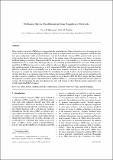Files in this item
Diffusion driven oscillations in gene regulatory networks
Item metadata
| dc.contributor.author | Macnamara, Cicely Krystyna | |
| dc.contributor.author | Chaplain, Mark Andrew Joseph | |
| dc.date.accessioned | 2017-07-20T23:33:47Z | |
| dc.date.available | 2017-07-20T23:33:47Z | |
| dc.date.issued | 2016-10-21 | |
| dc.identifier.citation | Macnamara , C K & Chaplain , M A J 2016 , ' Diffusion driven oscillations in gene regulatory networks ' , Journal of Theoretical Biology , vol. 407 , pp. 51-70 . https://doi.org/10.1016/j.jtbi.2016.07.021 | en |
| dc.identifier.issn | 0022-5193 | |
| dc.identifier.other | PURE: 244397967 | |
| dc.identifier.other | PURE UUID: 160e339a-38f6-4516-90d9-b367f27fff15 | |
| dc.identifier.other | Scopus: 84979533470 | |
| dc.identifier.other | ORCID: /0000-0003-4961-6052/work/27162488 | |
| dc.identifier.other | ORCID: /0000-0001-5727-2160/work/55378857 | |
| dc.identifier.other | WOS: 000383111800005 | |
| dc.identifier.uri | https://hdl.handle.net/10023/11258 | |
| dc.description.abstract | Gene regulatory networks (GRNs) play an important role in maintaining cellular function by correctly timing key processes such as cell division and apoptosis. GRNs are known to contain similar structural components, which describe how genes and proteins within a network interact - typically by feedback. In many GRNs, proteins bind to gene-sites in the nucleus thereby altering the transcription rate. If the binding reduces the transcription rate there is a negative feedback leading to oscillatory behaviour in mRNA and protein levels, both spatially (e.g. by observing fluorescently labelled molecules in single cells) and temporally (e.g. by observing protein/mRNA levels over time). Mathematical modelling of GRNs has focussed on such oscillatory behaviour. Recent computational modelling has demonstrated that spatial movement of the molecules is a vital component of GRNs, while it has been proved rigorously that the diffusion coefficient of the protein/mRNA acts as a bifurcation parameter and gives rise to a Hopf-bifurcation. In this paper we consider the spatial aspect further by considering the specific location of gene and protein production, showing that there is an optimum range for the distance between an mRNA gene-site and a protein production site in order to achieve oscillations. We first present a model of a well-known GRN, the Hes1 system, and then extend the approach to examine spatio-temporal models of synthetic GRNs e.g. n-gene repressilator and activator-repressor systems. By incorporating the idea of production sites into such models we show that the spatial component is vital to fully understand GRN dynamics. | |
| dc.format.extent | 20 | |
| dc.language.iso | eng | |
| dc.relation.ispartof | Journal of Theoretical Biology | en |
| dc.rights | © 2016, Elsevier Ltd. This work is made available online in accordance with the publisher’s policies. This is the author created, accepted version manuscript following peer review and may differ slightly from the final published version. The final published version of this work is available at www.sciencedirect.com / https://dx.doi.org/10.1016/j.jtbi.2016.07.021 | en |
| dc.subject | Hes1 protein | en |
| dc.subject | Synthetic networks | en |
| dc.subject | Repressilators | en |
| dc.subject | Activator-repressor systems | en |
| dc.subject | Spatial modelling | en |
| dc.subject | RC0254 Neoplasms. Tumors. Oncology (including Cancer) | en |
| dc.subject | QA Mathematics | en |
| dc.subject | QH301 Biology | en |
| dc.subject | NDAS | en |
| dc.subject | SDG 3 - Good Health and Well-being | en |
| dc.subject.lcc | RC0254 | en |
| dc.subject.lcc | QA | en |
| dc.subject.lcc | QH301 | en |
| dc.title | Diffusion driven oscillations in gene regulatory networks | en |
| dc.type | Journal article | en |
| dc.description.version | Postprint | en |
| dc.contributor.institution | University of St Andrews. Applied Mathematics | en |
| dc.identifier.doi | https://doi.org/10.1016/j.jtbi.2016.07.021 | |
| dc.description.status | Peer reviewed | en |
| dc.date.embargoedUntil | 2017-07-20 |
This item appears in the following Collection(s)
Items in the St Andrews Research Repository are protected by copyright, with all rights reserved, unless otherwise indicated.

